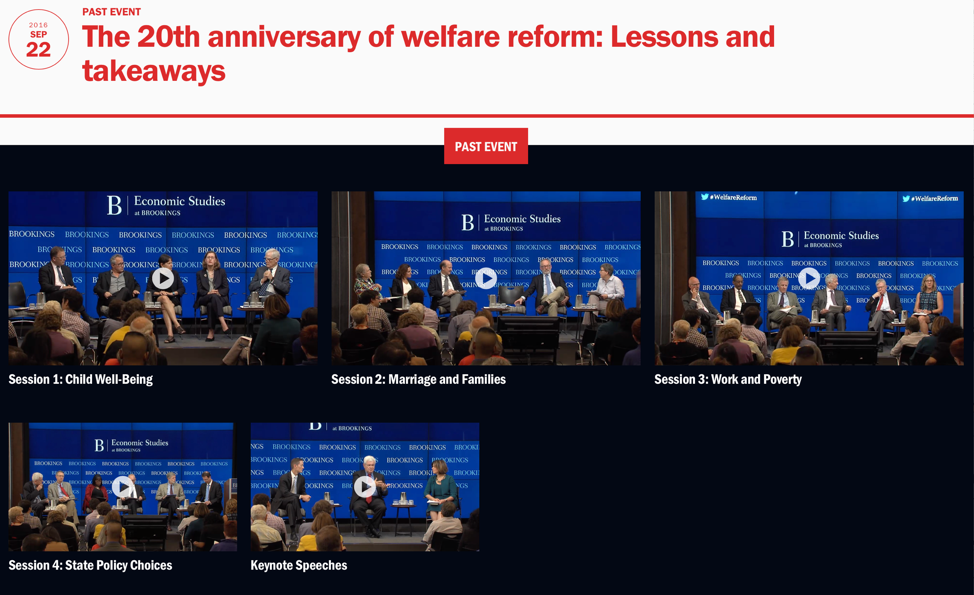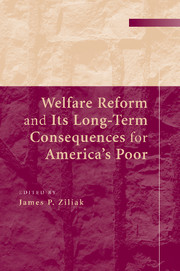Does managed care produce lower health care utilization and costs through better aligned financial incentives and alternative delivery methods (the “pure” HMO effect) or by attracting more healthy enrollees (enrollee selection)? The purpose of this paper is to shed new light on this fundamental question using a quasi-experimental approach that exploits the timing and county specific implementation of Medicaid managed care plans in two distinct sub-sets of Kentucky counties in the late 1990s. We find large differences in the relative success of each region in reducing utilization that are likely driven by important differences in plan design. Asthmatic children enrolled in the plan that was successful at reducing utilization did not appear to suffer adverse health outcomes as a result.
Welfare Reform and Transfer Programs
Since its inception in 2002, UKCPR has contributed fundamental research on the consequences of the 1996 welfare reform. The Personal Responsibility and Work Opportunity Reconciliation Act (PRWORA) ended the cash entitlement of the Aid to Families with Dependent Children (AFDC) program and replaced it with the block grant-funded Temporary Assistance for Needy Families (TANF). The new program made assistance contingent on work activity and time limited, restricted Supplemental Security Income (SSI) for children and noncitizens and food stamps for adults without dependents, enhanced child support enforcement, and permitted government funding of religious organizations to provide social services.
UKCPR marked the 10th and 20th anniversaries of TANF with major research conferences. The first resulted in the 2009 publication of Welfare Reform and its Long-Term Consequences for America's Poor at Cambridge University Press. The second conference was held in 2016 at Brookings Institution. It included a conversation with Newt Gingrich, who was Speaker of the House during welfare reform, and Bruce Reed, who was domestic policy advisor to President Clinton. The session was moderated by Diane W. Schanzenbach of Northwestern University. Along with UKCPR, the event was co-sponsored by the Institute for Research on Poverty, the Stanford Center on Poverty and Inequality, and the University of California-Davis Center for Poverty Research. A full listing of the agenda, along with video of the event, can be found here. Two publications followed, one an issue of Fast Focus published by the Institute for Research on Poverty and the second in a 2018 issue of Pathways Magazine published by the Stanford Center on Poverty and Inequality.
2011
2009
Intergenerational effects of welfare reform
This paper estimates the impact of the fundamental welfare reforms of the 1990s on the educational attainment of children in low-income families. Using data from national surveys of individuals and administrative records of school districts spanning the period from the early 1990s to the mid 2000s, we estimate the net effects of welfare reform in a difference-indifferences framework. We find that low- and higher-income children experience statistically indistinguishable time trends in outcomes prior to reform, whereas in sharp contrast, in the period following welfare reform, low-income children experience significant and growing relative gains in educational attainment. The income gaps in school enrollment and 7-12th grade drop-out rates narrow by more than 20% in the years following welfare reform. These findings are robust to changing the definition of low- and higher-income groups and to controlling for contemporaneous economic and policy changes.
The organization of discipline: From performance management to perversity and punishment
Poverty programs in recent decades has been transformed by the convergence of paternalistic and neoliberal approaches to administration. This has resulted in a devolution of program control to local jurisdictions. we seek to bridge this divide. Drawing on intensive field research and administrative data from the Florida Welfare Transition (WT) program, we present an empirically-grounded analysis of how organizations carry out the work of discipline in a decentralized, performancedriven policy system.
2008
Distributing discipline: Race, politics, and punishment at the frontlines of welfare reform
Numerous studies have confirmed that race plays an important role in shaping public preferences toward both redistribution and punishment. Likewise, studies suggest that punitive policy tools tend to be adopted by state governments in a pattern that tracks with the racial composition of state populations. Such evidence testifies to the enduring power of race in American politics, yet it has limited value for understanding how disciplinary policies get applied to individuals in implementation settings. To illuminate the relationship between race and the application of punitive policy tools, we analyze sanction patterns in the TANF program. Drawing on a model of racial classification and policy choice, we test four hypotheses regarding client race and sanctioning. Our study does not support a simple story in which racial minorities are always more likely to be targeted for discipline. Rather, we find the impact of race to be contingent on local politics, administrative decentralization, and other client characteristics.
The effects of Food Stamps on exiting welfare and becoming employed for welfare recipients
Welfare reform’s success encouraging employment may be affected by the federal Food Stamp program because many households receive welfare and Food Stamps. Food Stamp benefits could discourage employment because benefits are reduced proportionally with income; alternatively, it could encourage employment by increasing stability and allowing more resources to be allocated toward employment-related expenses. I examine the effects of Food Stamps on exiting welfare and becoming employed for welfare recipients. Results suggest, if anything, that Food Stamps discourage employment, and such benefits may discourage transitions off welfare, too. If so, then it may be necessary to study the determinants of welfare participation (welfare reform and economic growth) in conjunction with other government-assistance programs.
Distributional effects of programmatic features of Medicaid/SCHIP on transitions from private insurance coverage among U.S. low-income children: A dynamic approach
The goal of this study is to evaluate the effects of Medicaid/SCHIP eligibility and programmatic features on transitions from private insurance coverage among samples of American low-income children using monthly data from the 2001 panel of the Survey of Income and Program Participation (SIPP), a nationally representative data set. The estimation approach combines multilevel modeling and event history analysis, including a robust array of variables measuring programmatic features, individual child, family, and state attributes. Logistic regression results do not indicate an adverse effect of expanded Medicaid/SCHIP eligibility on private insurance coverage. Results also suggest that states which established stand-alone SCHIP programs can potentially limit crowd-out better than states which simply expanded their existing Medicaid programs and that waiting periods of less than six months might have a negative impact on private insurance coverage. Future studies should examine, in greater detail, how program features and other social policies can reduce crowd-out, while increasing public insurance take-up rates among the neediest populations.
Welfare reform and juvenile arrests
Social policy, such as the legalization of abortion and the federal bans on lead in the 1970s, has been shown to significantly impact crime rates. With recent increases in juvenile arrests and violent crime rates, we explore whether further social policy—namely the 1996 Personal Responsibility and Work Opportunity Reconciliation Act (PRWORA) welfare reform—has had an impact on crime. Our results suggest that stricter work requirements experienced by 13 to 15 year-olds increase their violent crime activity 2 to 4 years later. An increase of one standard deviation in the severity of the work requirement policy results in 5.5 more annual violent crime arrests per capita, an 14.5 percent increase. These results indicate that states should consider options for mitigating these effects, such as support services targeted at teenagers, when implementing the stricter federal work requirements outlined in the Deficit Reduction Act (DRA) of 2005. Conversely, we find no effect of welfare work requirements on juvenile property crime arrests, consistent with the literature on crime and delinquency among juveniles of low-socioeconomic status.
Paying for the Relocation of Welfare Recipients: Evidence from the Kentucky Relocation Assistance Program
In May of 1998, the Relocation Assistance Program (RAP) was introduced in Kentucky as a means of aiding welfare recipients to achieve self-sufficiency by offering lump-sum payments to those who wished to relocate to seek or accept employment. Unlike other relocation assistance programs, this program provides moving assistance to welfare clients rather than to unemployed persons or dislocated workers. We relate this program to other relocation programs as well as to the UI bonus experiments. We also survey the theoretical literature to give some intuition for the effects of the program on earnings and employment for welfare clients. Using program participation to measure the treatment effect is a contentious issue due to program requirements linking employment to participation. Given that advertising would certainly influence participation, we construct an advertising proxy that differs from program uptake/utilization to identify the program’s effects. Working with a relatively short, panel administrative dataset, we find that a one standard deviation increase in the RAP proxy is associated with a 20.4 percent increase in employment and a 18.3 percent increase in quarterly unconditional earnings, which is robust to various specification checks.
2007
Does welfare reform work in rural America? A 7-year follow-up
Even before the advent of welfare reform, studies of low income working and welfare dependent groups showed that low wage working women are worse off than those who combine welfare with other income sources and that most used a wide variety of livelihood strategies. This is especially the case in poor rural settings where work is scarce and additional obstacles to employment such as lack of transportation and childcare are endemic. Data from a selfadministered survey of users of human service agency programs in four counties in a distressed region of Appalachian Ohio in 1999, 2001, and 2005, provide a comprehensive picture of livelihood strategies, including labor force participation, informal and self-provisioning practices, and use of government and private transfers early and late in the welfare reform process. We compare working and nonworking human service clients at all three time periods and across communities with different levels of capacity to implement welfare to work policies to determine how labor force participants differ from other recipients and whether they are better or worse off. The data demonstrate the problems in making ends meet for all respondents, regardless of employment status and county capacity in all three time periods. While county differences are minimal, workers are better off than nonworkers and more so by the third survey year. They employ a wide variety of livelihood strategies be
2006
Welfare and work: Comparing full and partial sanctions on the front lines
This study contrasts partial and full family work sanctions by examining their administration in Texas, a state that initially imposed a partial benefit sanction, and then changed to full benefit sanctions. Using administrative fair hearing data, this study uses a qualitative research design to examine how full and partial sanctions may differ, and how front line workers administer both types of sanctions. This study found that recipients’ reasons for not complying with work rules were similar under both regimes and that full family sanctions did not provide an increased incentive to overcome obstacles and barriers to work. Workers responses under both regimes were also very similar, with workers creating the welfare-to-work version of an eligibility-compliance culture. The findings of this study suggest that a better balance between supports and sanctions is needed.

